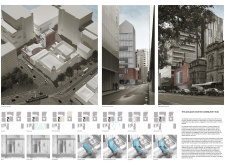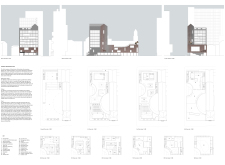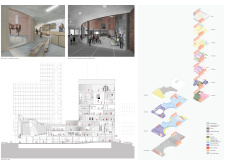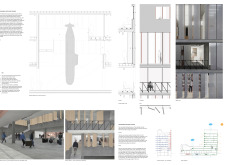5 key facts about this project
The concept behind this project revolves around sustainability and community engagement. Designed as a multifunctional space, the architecture serves various purposes, including residential, social, and recreational facilities. This multi-dimensional approach allows it to fulfill pressing community needs while also providing a space for gathering, interaction, and activity. The architects have effectively blended different spatial experiences, creating areas that promote both privacy and communal engagement. This thoughtful balance enhances the overall user experience, allowing the building to function not only as a physical structure but also as a central hub for community life.
The exterior of the building is notable for its materiality, which combines local resources with modern construction techniques. The use of reinforced concrete provides a robust framework, while large glass panels enhance connectivity with the outside world, inviting natural light into interior spaces and framing views of the surrounding landscape. This transparency is juxtaposed with the warmth of wooden accents, which are carefully integrated to soften the facade and add a tactile quality that enhances the overall aesthetic. These thoughtful choices reflect a commitment to sustainability, with materials selected not only for their aesthetic properties but also for their environmental impact, contributing to energy efficiency and ecological awareness.
As one explores the interior spaces, the design reveals a well-considered layout that promotes ease of movement and interaction. Strategic placement of common areas such as lounges, meeting rooms, and recreational spaces encourages collaboration and social interaction among users. Natural light floods the interiors through carefully positioned windows and skylights, enhancing the atmosphere and making the space feel open and inviting. The interior finishes carry a consistent theme of understated elegance, characterized by neutral color palettes and a blend of natural materials that work together to create a cohesive and serene environment.
The landscaping surrounding the project also plays a crucial role in enhancing the overall aesthetic and functional attributes. Thoughtfully designed outdoor spaces, including gardens and plazas, offer additional areas for relaxation and social gatherings. The selection of native flora not only supports local biodiversity but also reduces maintenance needs, reflecting a design approach that prioritizes ecological responsibility. These elements encourage users to engage with their environment, fostering a sense of connection to the natural surroundings.
One of the standout aspects of this architectural project is its innovative approach to blending indoor and outdoor environments. Features such as large sliding doors and strategically placed balconies allow for seamless transitions between interior and exterior spaces, enhancing the overall experience of the building. This connection not only provides additional square footage during favorable weather conditions but also cultivates a deeper relationship between the inhabitants and their surroundings.
Furthermore, the design incorporates modern sustainable technologies, such as rainwater harvesting systems and energy-efficient heating and cooling solutions. These features enhance the building's sustainability profile and demonstrate a forward-thinking approach to architecture that prioritizes environmental stewardship.
Overall, this architectural project serves as an exemplary case of how thoughtful design can create spaces that are both functional and deeply connected to their context. The project embodies principles of sustainability, community engagement, and environmental sensitivity, showcasing the potential of architecture to enhance daily life. For those interested in exploring the intricate details of the design, including architectural plans, sections, and other design elements, a deeper look at the project presentation is encouraged to gain fuller insights into the architectural ideas that drive it forward.


























